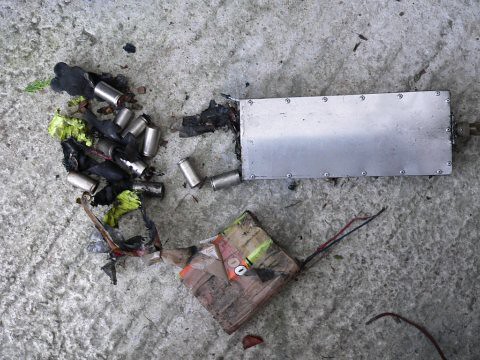Near-disaster struck in the early hours today,when my 36V NiMH battery caught fire whilst on charge. Foolishly I was charging it in the house, but was awoken by the bang of the first cell exploding and was able to get the (very hot and smoking) pack outside.
Despite having played with this sort of stuff for years, I learned some very salutary lessons, albeit by nearly burning the house down.
1) I blithely assumed that I could charge a NiMH pack at the 0.1C rate without risk, based on lots of experience of charging NiCd packs over the years. Wrong! Unlike NiCd, it seems that NiMH can reach thermal runaway temperatures even at such low charge rates.
2) I assumed that two sub-packs of 36V, 3.7Ah, charged in parallel (via a pair of matched diodes) from a constant current source would current share. Wrong! It seems that one of the two sub-packs took more current than the other, as in the charred wreckage it looks like one sub-pack is relatively undamaged, whilst the cells of the other are totally burnt out. To do this safely will mean using two chargers, one for each sub pack, or charging the sub-packs seperately.
3) I'd fitted thermistors to monitor pack temperatures, but hadn't yet built the custom variable rate charger. I was using a big constant current power supply, set to charge at 750mA. The total pack capacity was 7.4Ah and the cells were all fully discharged at the start of the charge. I should have fitted thermal fuses or cut outs.
Some details:
The two sub-packs are each made up from four 12V 3700mAh sub-C cell packs. I don't believe that the batteries were at fault.
They had been on charge for about nine hours when the first cell went bang and woke me up. I got up to investigate after the second cell went bang and just had time to get into the study, disconnect the leads and carry the smoking pack outside the back door before it very dramatically caught fire. I carried the pack by the cable and as I got to the path outside the burning cells started dropping out of the pack.
The fire was pretty fierce, with the remainder of the cells in the damaged sub-pack exploding quite violently. All that is left of that pack is some charred remnants and a few bits of bent metal.
Hopefully my very stupid mistake might prevent someone else doing something similar. Certainly I won't ever charge batteries indoors again, no matter what safety systems are installed. From now on all batteries will be charged on an open bit of concrete, free from all flammable material!
Jeremy
Despite having played with this sort of stuff for years, I learned some very salutary lessons, albeit by nearly burning the house down.
1) I blithely assumed that I could charge a NiMH pack at the 0.1C rate without risk, based on lots of experience of charging NiCd packs over the years. Wrong! Unlike NiCd, it seems that NiMH can reach thermal runaway temperatures even at such low charge rates.
2) I assumed that two sub-packs of 36V, 3.7Ah, charged in parallel (via a pair of matched diodes) from a constant current source would current share. Wrong! It seems that one of the two sub-packs took more current than the other, as in the charred wreckage it looks like one sub-pack is relatively undamaged, whilst the cells of the other are totally burnt out. To do this safely will mean using two chargers, one for each sub pack, or charging the sub-packs seperately.
3) I'd fitted thermistors to monitor pack temperatures, but hadn't yet built the custom variable rate charger. I was using a big constant current power supply, set to charge at 750mA. The total pack capacity was 7.4Ah and the cells were all fully discharged at the start of the charge. I should have fitted thermal fuses or cut outs.
Some details:
The two sub-packs are each made up from four 12V 3700mAh sub-C cell packs. I don't believe that the batteries were at fault.
They had been on charge for about nine hours when the first cell went bang and woke me up. I got up to investigate after the second cell went bang and just had time to get into the study, disconnect the leads and carry the smoking pack outside the back door before it very dramatically caught fire. I carried the pack by the cable and as I got to the path outside the burning cells started dropping out of the pack.
The fire was pretty fierce, with the remainder of the cells in the damaged sub-pack exploding quite violently. All that is left of that pack is some charred remnants and a few bits of bent metal.
Hopefully my very stupid mistake might prevent someone else doing something similar. Certainly I won't ever charge batteries indoors again, no matter what safety systems are installed. From now on all batteries will be charged on an open bit of concrete, free from all flammable material!
Jeremy







